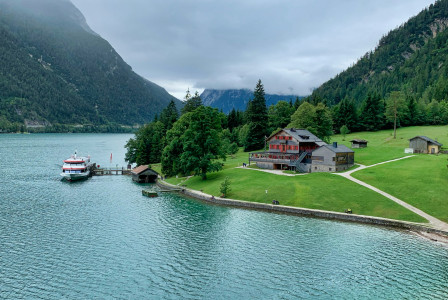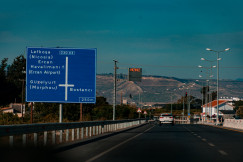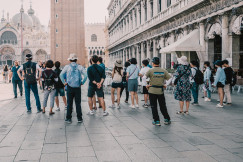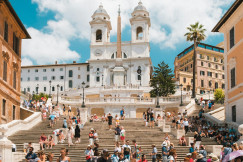Articles
02 September 2025
From Sustainability to Regeneration – Rethinking Destination Management in Europe
Articles
02 September 2025
Adventure tourism
Coastal, maritime and inland water tourism
Cultural tourism
+40 more
Login / create an account to be able to react
-
500

European tourism is shifting from sustainability to regeneration, focusing not just on minimising harm but on actively restoring ecosystems, supporting local communities, and creating long-term value. Backed by EU policies and projects, regenerative tourism aims to make destinations more resilient and equitable through inclusive governance, better data, and support for SMEs - responding to growing pressures from climate change and overtouris
Topics
Albania
Armenia
Austria
Belgium
Bosnia and Herzegovina
Bulgaria
Croatia
Cyprus
Czechia
Denmark
Estonia
EU-27
Finland
France
Georgia
Germany
Greece
Hungary
Iceland
Ireland
Italy
Kosovo
Latvia
Liechtenstein
Lithuania
Luxembourg
Malta
Moldova
Montenegro
Netherlands
North Macedonia
Norway
Poland
Portugal
Romania
Serbia
Slovakia
Slovenia
Spain
Sweden
Switzerland
Türkiye
Ukraine
Other
Academic / Research and VET Institutions
Business Support Organisation
Company with 250 or more employees
Cluster Organisations
Consumer Organisations
Cultural and Heritage Organisations
Destination Management & Marketing Organisations
EU Institutions
Financial Institutions and Investors
Industry Associations and Chambers of Commerce
International Organisations
Local Authorities
Media / Journalist Organisations
National authorities
Networks and Federations / Confederations
NGOs / Non-profits
Notified Bodies
Regional Authorities
SMEs (a company with less than 250 employees)
Social Economy Entity
Trade Unions
Other
-
Specific types of tourism
-
-
Adventure tourism
-
Coastal, maritime and inland water tourism
-
Cultural tourism
-
Ecotourism
-
Education tourism
-
Festival tourism
-
Gastronomy tourism
-
Health and medical tourism
-
MICE tourism
-
Mountain tourism
-
Religious tourism
-
Rural tourism
-
Sports tourism
-
Urban/city tourism
-
Wellness tourism
-
-
Transition Pathway Strategic Areas
-
-
Coordinated information on travelling
-
Cross-border travelling
-
-
Business activities
-
-
Activities of amusement parks and theme parks
-
Activities of associations and other organisations supporting tourism
-
Air passenger transport
-
Camping grounds, recreational vehicle parks and trailer parks
-
Events catering and other food services
-
Festivals, cultural and entertainment activities
-
Gardens and nature reserves activities
-
Holiday Housing / Apartments and other short stay accommodation
-
Hotel and similar accommodation
-
Mobile beverage services
-
Mobile food services
-
Museums
-
Operation of historical sites
-
Other
-
Other accommodation
-
Other amusement and recreation activities
-
Other food and beverage services
-
Other holiday reservation services
-
Other tourism transportation activities
-
Rail Passenger transport
-
Recreational and sport activities
-
Restaurants, cafes and bars (Food and Beverage serving activities)
-
Road passenger transport
-
Tour operator activities
-
Travel agency activities
-
Water (sea, coastal and inland) passenger transport
-
Share
The Shift in Mindset
For over two decades, sustainable tourism has been a guiding principle for European destinations. As defined by UN Tourism, it “takes full account of its current and future economic, social and environmental impacts, addressing the needs of visitors, the industry, the environment and host communities.” From eco-label hotels to waste minimisation schemes, the sector has achieved tangible results. Yet the reality on the ground is shifting. Extreme weather events damage infrastructure and natural attractions, rising seas threaten coastal heritage sites, and flows push communities and ecosystems to their limits. In cities from Barcelona to Dubrovnik, residents have called for more control over tourism’s footprint, and rural regions warn of losing their identity under a flood of seasonal visitors.
These pressures underscore the need to evolve and deepen sustainability in practice. Building on the sustainable tourism agenda, many European destinations are adopting a regenerative approach - one that extends sustainability by restoring what has been degraded, creating net-positive outcomes, and leaving places and communities stronger than before. Tourism itself cannot, on its own, be fully regenerative; it is an industry with the opportunity to contribute to regeneration, especially when destinations choose this approach.
Regenerative Tourism - Leaving a Positive Handprint
Regenerative tourism is a values-driven extension of sustainable tourism. It seeks to improve ecological health, cultural vitality, and social equity through tourism activity - building and revitalising natural, social and economic capital. It draws on Indigenous stewardship (people as part of nature), permaculture (systems that renew themselves), and systems thinking (destinations as living networks where environment, community resilience and economy are interdependent).
Rather than setting concepts against each other, regenerative approaches extend sustainability: they retain efficiency and impact-reduction (using fewer resources, reducing waste, lowering emissions) and add restoration, reciprocity, and community well-being as explicit outcomes. For the EU, this is an opportunity: a regenerative approach strengthens resilience, broadens value creation, and confers competitive advantage as Europe aims to remain a global leader in sustainable tourism.
From Vision to Practice: Policy, Projects & Governance
Turning regeneration from an aspiration into a workable strategy requires strong governance and supportive policy frameworks. The European Commission’s Sustainable EU Tourism - Shaping the Tourism of Tomorrow initiative helps destinations align the green and digital transitions with cultural and social objectives. It encourages place-based planning, where strategies are tailored to the unique character and needs of each region.
Projects like Cross-Re-Tour co-financed by COSME, support SMEs in adopting regenerative methods - combining circular economy approaches, climate adaptation, and digital tools to enhance resilience and competitiveness. The Transition Pathway for Tourism provides a structured framework for these changes, mapping key actions for stakeholders and linking them to EU funding streams. The upcoming EU Sustainable Tourism Strategy 2026 is expected to embed regeneration as a long-term goal across all member states.
Effective governance is participatory. Regenerative destination management often includes citizen assemblies, public consultations, and multi-sector partnerships. By giving residents a voice and a stake in the tourism model, destinations build trust and ensure that economic benefits and responsibilities are shared.
Concrete Regenerative Initiatives Across Europe
Drawing on best practices collected across the EU, destinations are showing how regenerative approaches work in the field:
Amsterdam’s Doughnut Economics - Applying the doughnut framework in tourism policy: limiting pressure in crowded areas, investing in sustainable mobility, and spreading benefits to less-visited districts.
National schemes - Beyond Slovenia Green, countries are scaling regeneration-aligned programmes such as Sustainable Travel Finland and the Austrian Ecolabel for Tourism, helping businesses and municipalities design restoration-oriented actions under coherent national umbrellas.
Biosphere Reserves across Europe - Visitor experiences are integrated with conservation finance: revenues support habitat restoration, local producers, and cultural education.
Ireland’s Just Transition regions - Former peat-cutting areas now feature cycling and walking networks, wetland restoration, and dozens of community-led regenerative enterprises.
SME enablers - Projects such as CE4RT and Interreg Euro-MED Regenera4MED help SMEs adopt low-impact, community-focused models that reduce pressures while building resilience.
Recognition mechanisms - The European Capital of Smart Tourism and Green Pioneer awards highlight destinations advancing innovation, accessibility and green transformation, encouraging peer learning.
Indicators That Reflect Regeneration
You can’t manage what you don’t measure. Traditional volume metrics (arrivals, overnights) say little about outcomes. High-level indicator families that align with our consultation work include:
Environmental condition (status and trends in ecosystems and resources)
Cultural vitality (safeguarding living heritage and local identity)
Resident well-being (quality of life, satisfaction, affordability)
Fair value distribution (how tourism income is shared across sectors and communities)
Emerging tourism data spaces and destination observatories can combine advanced monitoring (e.g., earth-observation inputs) with community-generated insights to make measures comparable, actionable and shareable across Europe.
Challenges & Enablers
Barriers remain: many systems still reward volume over outcomes; smaller destinations lack specialised expertise; and market signals often undervalue restoration. Enablers include policy alignment with climate and biodiversity goals; targeted capacity-building for authorities and SMEs; better data sharing; and community leadership that anchors decisions in local priorities. Public and private financing instruments can support pilots and scaling - without locking into specific programme labels, as frameworks continue to evolve.
Envisioning a Regenerative Future
The transition from extractive, volume-driven tourism to regenerative models is a necessity if Europe is to maintain the quality of its destinations. It requires coordinated EU-level frameworks, innovative financing, inclusive governance, and the integration of regeneration into tourism education and business models.
Regenerative tourism is more than a management tool; it is a mindset shift. It challenges all actors - governments, businesses, and visitors - to see themselves as custodians of the places they touch. When fully embraced, it can transform tourism into a force that restores landscapes, strengthens cultures, supports fair economies, and deepens the human connection to place.
Comments (0)
See also
The Unseen Barriers to Seamless Cross-Border Travel in the EU
- Categories
- Coastal, maritime and inland water tourism Cultural tourism Ecotourism +39 more
When Too Much Becomes Harmful: Rethinking Unbalanced Tourism in Europe
- Categories
- Coastal, maritime and inland water tourism Cultural tourism Ecotourism +64 more
Unbalanced Tourism Growth in Europe: Understanding Pressures, Impacts and Sustainable Pathways
- Categories
- Coastal, maritime and inland water tourism Cultural tourism Ecotourism +64 more




